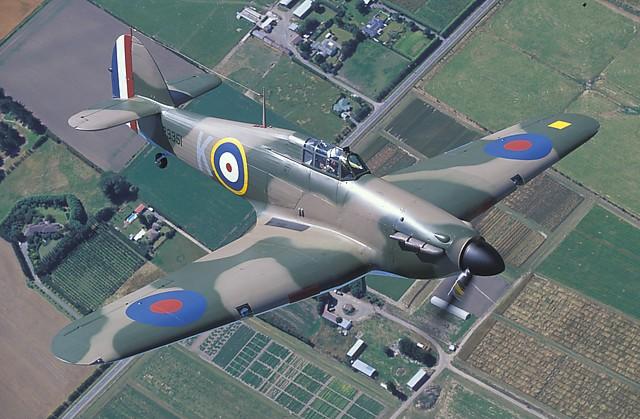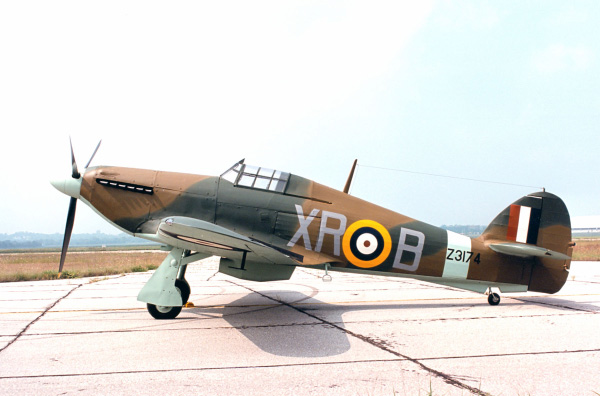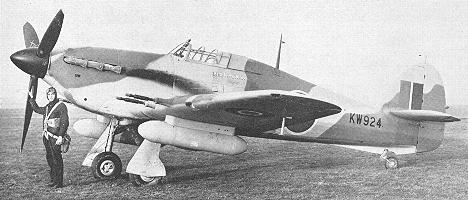
|
 |
Hawker Hurricane |
 |
 |
 |
 |
 |
|---|---|---|---|---|---|---|---|
 |
 |
 |
 |
 |
|||
 |
||
|
The early history of the Hurricane is an interesting parallel in many ways with that of the Supermarine Spitfire in with which it was to form an immortal partnership. While the Spitfire was an entirely new concept based on specialized experience, the Hurricane was the logical outcome of a long line of fighting aircraft. Although the two airplanes broadly met the same requirements, they represented entirely different approaches to the same problem. The two approaches were reflected to an interesting degree in their respective appearances; the Hurricane workmanlike, rugged and sturdy, the Spitfire slender and ballerina-like. One was the studied application of experience, the other a stroke of genius. |
| Often underrated in favor of the Spitfire, the Hurricane was the main victor of the Battle of Britain. The Royal Air Force had at that time 32 Hurricane squadrons, compared with 19 Spitfire squadrons. This meant that 620 Hurricane and Spitfire fighters (with another 84 assorted fighters like the Gloster Gladiator) had to face the German air threat of 3,500 bombers and fighters. During the "Battle of Britain", along with the Spitfire, it helped to force the Luftwaffe to use the Bf 109 to protect the poor performing twin engine Bf 110 escort fighter. |
|
The synthesis of many years' intimate experience of fighter biplane design,
translated into the modern formula; a compromise between tradition, and requirements born of a
new era in air warfare—such was the Hawker Hurricane. The Hurricane shouldered the lion's share
of Britain's defense during the "Battle of Britain" and was largely responsible for the successful outcome of this conflict. The Hurricane
equipped more than three-fifths of RAF's Fighter Command squadrons. The Hurricane
also proved to possess an astounding propensity for adaptation, and the multifarious roles that it
undertook earned for it the distinction of being the most versatile of single seat warplanes to
emerge from the Second World War.
The Hurricane was the work of Sydney Camm, who began its design in 1934. The prototype first took to the air on November 6,1935, at Brooklands, and the initial production Hurricane I entered RAF service in December 1937, with No 111 Squadron. Powered by the famous Rolls-Royce Merlin engine, it became the first RAF monoplane fighter with both an enclosed cockpit and retractable undercarriage and was the first RAF fighter monoplane capable of exceeding 300 mph in level flight.

Hawker Aircraft Limited evolved from Sopwith and had spent its entire life in developing single engined warplanes. None was to achieve more fame than the Hurricane. Early in 1934 Sydney Camm, chief designer of Hawker Aircraft, learned of the work being undertaken by Rolls-Royce to develop a powerful new engine, then known as the PV-12. At that time, the Hawker design team had been working on a fighter project known as the Fury Monoplane which had been designed around the 660 hp Rolls-Royce Goshawk steam-cooled engine. As the new engine offered a substantial improvement in performance, the projected fighter was redesigned for the new power plant. In view of Air Ministry interest, project design work was rapidly completed, stressing commencing in March 1934, and work on detail drawings beginning in May. On October 23, 1935, the prototype fighter, bearing the serial number K5083, was moved from Kingston to Brooklands for its first flight, which was effected on November 6 with P. W. S. "George" Bulman, the company's chief test pilot, at the controls. As measured at Brooklands, the prototype's loaded weight was 5,416 lbs. The Hawker monoplane was a clean aircraft, with tubular metal construction and fabric covering, similar to those of the earlier Fury fighter biplanes. Many of its contours, particularly the tail surfaces, were characteristic of earlier Camm designs. The continued adherence to fabric covering was viewed with misgivings by some, and was, in fact, soon to be supplanted by metal skinning for the wings; but this seemingly dated feature was linked with what were for that time ultra-modern items such as a fully retractable under-carriage and a sliding cockpit canopy. For its first flight the fighter was powered by a Merlin "C", the name that had earlier been bestowed upon the PV-12, which drove a Watts two-bladed, fixed-pitch wooden propeller. Under the command of Sqn. Ldr. J. W. Gillan, No. 111 Squadron quickly settled down with its new monoplanes, and on February 10, 1938, the commander personally demonstrated the prowess of the Hurricane by flying from Edinburgh to Northolt at an average speed of 408 mph. Squadrons were rapidly equipped with the Hurricane, thanks to the foresight of the Hawker Aircraft directors. At the time war was declared on September 3, 1939, nearly 500 Hurricanes had been delivered and eighteen squadrons had been equipped. These were all of the Mark I type, armed with eight 0.303-in. machine-guns but having alternative propeller installations. The mix included Merlin II engines driving a Watts two-blade fixed-pitch wooden propeller, or a Merlin III of similar power having a standardized shaft for de Havilland or Rotol three-blade metal propellers. The Hurricane I, at 7,127 lbs., possessed a maximum speed of 325 mph at 17,500 feet, a range of 700 miles at 200 mph at 15,000 feet, a service ceiling of 36,000 feet, and the ability to climb to 20,000 feet in 9 minutes.

When it became clear that the Hurricane was becoming outclassed as a pure fighter, other duties were assigned to it. The 'Hurribomber' fighter-bomber came into being, carrying either two 113 kg (250 lb) or two 226 kg (500 lb) bombs under its wings. During the Battle of Britain, which began in earnest on August 8,1940, Hurricanes concentrated mainly on the destruction of the German Heinkel He 111 and Dornier Do 17 bombers. These were the aircraft that would cause the most damage if allowed to get through. The only Victoria Cross ever awarded to a Fighter Command pilot was won by Ft Lt James Nicolson, a Hurricane pilot of No 249 Squadron who, on August 16, 1940, while attacking a German aircraft in front of him, was pounced on from above and behind by other German aircraft. Nicolson's aircraft caught fire, but he continued his attack until he had shot down his original target, then parachuted to safety. The highest scoring Allied pilot of the battle - a Czech named Sergeant Josef Frantisek, who claimed 17 victories - was also a Hurricane pilot. When it became clear that the Hurricane was becoming outclassed as a pure fighter, other duties were assigned to it. In October 1941 the 'Hurribomber' fighter-bomber came into being, carrying either two 113 kg (250 lb) or two 226 kg (500 lb) bombs under its wings. The Mk IID of 1942 was fitted with two 40 mm cannon for tank busting and two machine-guns, and was operated mainly in North Africa against Rommel's desert forces and in Burma against the Japanese. Other Hurricanes carried rocket projectiles as alternative ground attack weapons. The year 1943 saw two important developments in the Hurricanes history—the introduction of the Mark IV and the adoption of the Hurricane to fire rocket missiles or, as they were initially known, "unrifled projectiles". The Hurricane IV differed from the Mark II in two respects: it used a Merlin 24 or 27 which developed 1,620 hp for take-off, and it featured "low attack" or universal armament wings. These wings were derived from those fitted to the Hurricane IID and could carry the 40-mm. Vickers or Rolls Royce cannon, bombs, drop-tanks or rocket projectiles. The Hurricane IV was in service by March 1943 and was operational in the Middle and Far East theatres until the end of the war, and in Europe until the end of 1944. The development of the aircraft rocket had introduced a new factor in the use of aircraft as ground-assault weapons, and the Hurricane IIB and IIC were the first single-seaters to employ the rockets operationally. After extended trials at the A. & A.E.E. and elsewhere with rockets launched from Hurricanes (commencing with Z2415 which was fitted with three launching rails under each wing early in 1942), No. 137 Squadron took its rocket carrying Hurricanes into action for the first time at the beginning of September 1943. Hurricane IIBs, IICs, and IVs were fitted with four rockets under each wing.

A late series Hurricane IIC with two 44 gallon auxiliary drop tanks. Perhaps the most important sub-variant was the Sea Hurricane. This operated from aircraft carriers, being fitted usually with catapult spools and arrester hook. However, most Sea Hurricanes were not newly-built fighters but converted RAF types, and were deployed originally not for aircraft carrier operations but to protect merchant shipping. To combat German maritime-reconnaissance bombers, some ships were converted into CAMs (catapult aircraft merchantmen) which meant that a Hurricane fighter could be launched from the ship when danger approached. The biggest problem was that the fighter could not re-land on board, and so the pilot had to ditch it in the sea. The main areas of operation for the 'Catafighters' were in the Mediterranean and Baltic, but by 1943 the Sea Hurricane had all but disappeared from service. Of the 14,533 production Hurricanes built, some had gone for service with other air forces. In particular, nearly 3,000 were dispatched to the Soviet Union to aid its fight against the Germans on the Eastern Front. The first Hurricane sorties in Russia were made on September 11,1941 in defense of Murmansk, pilots from France, Britain and America helping the Soviets in their task. |
| Specifications: | |
|---|---|
| Hawker Hurricane II B | |
| Dimensions: | |
| Wing span: | 40 ft. 0 in. (12.19 m) |
| Length: | 32 ft. 3 in. (9.82 m) |
| Height: | 8 ft. 9 in. (2.66 m) |
| Weights: | |
| Empty: | 5,658 lb (2,566 kg) |
| Operational: | 8,470 lb. (3,841 kg) with two 500-lb. bombs. |
| Performance: | |
| Maximum Speed: |
340 m.p.h. (547 km/h) @ 21,000 ft. (6,400 m) clean 320 m.p.h. (514 km/h) @ 19,700 ft. (6,004 m) with two 250-lb. bombs 307 m.p.h. (494 km/h) @ 19,500 ft. (5,943 m) with two 500-lb. bombs |
| Service Ceiling: |
40,000 ft. (12,192 m); clean 33,000 ft. (10,058 m); with 500-lb. bomb load. |
| Range: |
460 miles (740 km) at 178 mph (286 km/h) normal fuel. 920 miles (1,480 km) with two 44 gallon auxiliary tanks. |
| Powerplant: | |
|
One Rolls-Royce Merlin XX twelve-cylinder 60 deg. Vee liquid-cooled
engine rated at 1,280 h.p. (954 kw) @ take-off and 1,850 hp (1,379 kW) @ 21,000 ft. (6,400 m). | |
| Armament: | |
|
Twelve Browning .303 machine-guns and two 250-lb. or 500-lb. bombs or eight rocket projectile. | |
© The Aviation History Online Museum.
All rights reserved.
Created October 19, 1996. Updated December 29, 2022.